|
Lockwood
Custom Optics
at the Winter Star Party 2023 Return to the southern skies All images and text Copyright Mike Lockwood, 2023. May not be used without permission. |
 Well, the last line I wrote in my WSP 2020 article mentioned WSP 2021, and of course that event was cancelled. It really surprised me that WSP 2022 was cancelled too, likely based on excessive caution, so I missed my Florida fix for two straight winters. I was sick of continuous winter (without some fun interruptions), so I was eager to get back to Florida friends and relatives and the Keys. As I write this, fall is setting in, the crops have been harvested, and I've just been too busy to catch up on writing after a fun and productive summer enjoying the outdoors and the water, doing outdoor landscaping projects, moving dirt. I have not been working overtime doing optical work and thus missing out on the summer weather. I am slowly learning not to over-schedule myself. However, now I have to get back into my frame of mind from earlier in the year, when I finally got to go south in February. After running over a deer carcass that shot out from under the tractor-trailer in front of me in November, my car was driveable, but the shop didn't have time to repair it until January. When I finally took it in, of course they took longer than they estimated, so it was not ready for my trip. Perfect. I actually thought about canceling the trip. I ended up renting a minivan (at a discount thanks to insurance arrangements) which made the trip more expensive, but gave me more than ample cargo room to bring a telescope. I normally don't have the room in my Outback with all the other stuff that I bring to Florida (golf clubs, etc.). It was a hybrid minivan, and it surprised me with how well it accelerated when getting on the highway, and how well it drove generally. I made mental notes for future vehicles. Stubby, my 14.5" f/2.55 Newtonian, built in 2009 to test my limits and the limits of the then-new Paracorr 2 (see Okie-Tex 2009 article here for more), was selected, along with nightvision gear. After a day's drive, I visited friends in Alabama, who were also attending WSP, then I headed to the Orlando area for some slalom waterski lessons. The final stop before the Keys was my relatives on the east coast, about an hour southeast of Orlando. Florida is busier than ever, and I am content to visit a couple of times per year. The traffic and humidity are too much for me to deal with year-round, but in the winter it's perfect. Sunshine is great for the soul, but a crowded interstate is not. Traffic was a bit lighter than normal heading into the keys, and the normal Isla-hell-rada backup was pretty minimal. (There are frequently miles-long backups on Islamorada in the upper keys, so I renamed it.) I arrived in Marathon on a cloudy Sunday afternoon, picked up some provisions, and headed out to the camps. Plural. Yes, that's right, the star party now uses both camps for the event, with power and showers in the Boy Scout camp on the west end of the island, and no power in the Girl Scout camp on the east end because it was not restored after the latest hurricane. I said hello to the staff, and it was wonderful to see them after so long. I had talked to a few of them on the phone and traded texts and emails, but it's always good to shake a real hand and catch up on life in person. As often happens, it was Super Bowl Sunday, and the game was streamed on a TV on the outside of an RV. In previous years when the Wheelhouse was not condemned, we would watch it in the large meeting room, but sitting outdoors encourages one to consider observing if the game is not exciting and the skies beckon. They did for me. It's difficult to resist Orion and the winter Milky Way 15 degrees higher than I see them at home, and in a darker sky, especially after a three-year wait. The photo at right and above, a vertical panorama, shows what is visible, with Canopus above one of the telescopes set up literally on the beach mere feet from the ocean. When it is calm, the reflection of Canopus is quite prominent on the water, and there have been some magical nights in the past where the wind dropped and the water reflected the southern sky. However, this year it was breezy, and it started off clear. The wind was a cool one out of the northwest, typical of the wind direction after a front has passed through, usually bringing poorer than normal seeing. Joe arrived on Sunday and came in as my guest. He set up his 32" f/3.6 at the east end of the camp, up against the trees by the road, which we often use as a windbreak. It worked well on this night. We observed visually and hit the highlights that we had not seen under southern skies for three years. M42 is an obvious target, and it was beautiful even though it would not support the 1000x power that we would sometimes use on really steady nights to try to spot 10 or 11 stars in the Trapezium (see my WSP 2020 article for that). We also observed NGC 4565, M46, the Leo trio, M95, and M96. The moon came up about 11:30pm, so we called it a night. I headed back over to the boy scout camp to the tent that I was staying in and turned in for the night. It was warm, but I managed to sleep in the somewhat conditioned tent. I was sharing with a couple of the other speakers, who seemed to never sleep, or they were elsewhere. I wish I could stay up all night and still function the next day, but it just doesn't work for me. Monday was sunny and nice, and everyone came in and filled up the site with cars, RVs, telescopes, and tents. It was good to see things back to normal.  There was a new addition this year, a different food truck that had paella on Monday night, and it was delicious. I was cooking some meals with friends and we also went out quite a few nights for dinner, and I feel bad that I didn't get to enjoy more of their excellent food. The east end of the site now has rock put down in the driveways to raise them and make them more solid, and some areas have been filled so they don't flood. The old "berm" is now mostly sand, and hopefully vegetation will once again take hold and become more of a lawn if the hurricanes hold off for a while. 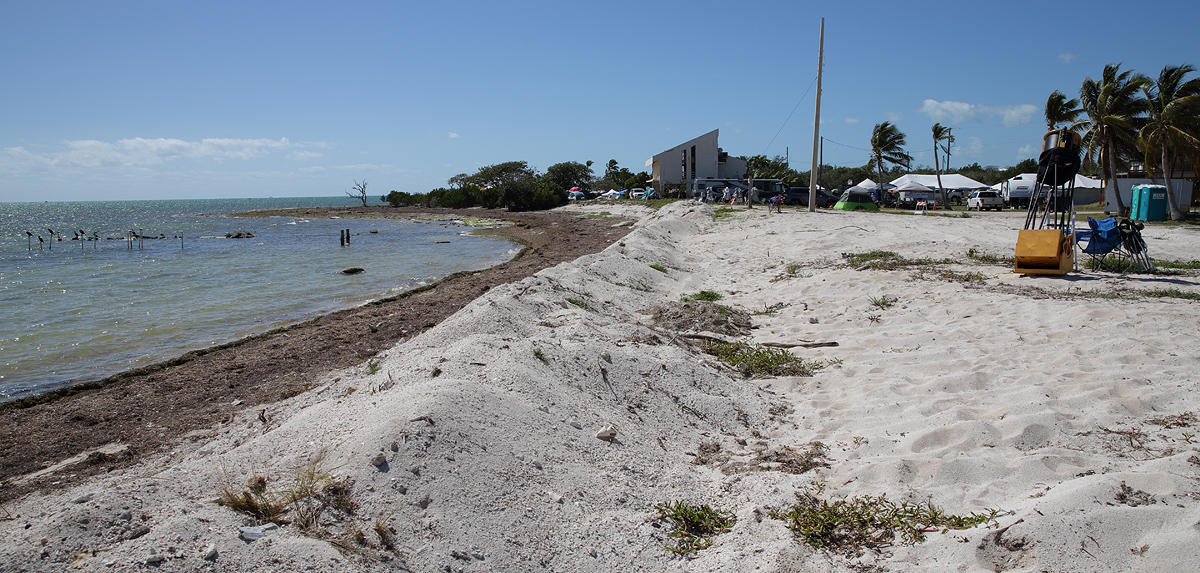 Monday night's observing was good, but again the seeing was not as good as possible due to the wind direction. We used John's 22" f/3.3 JPAstrocraft and my 14.5" f/2.55 with afocal nightvision and usually a 41mm Panoptic. We saw the Horsehead visually in the 22" f/3.3 with an H-beta filter, but transparency was not superb so it was difficult. With my nightvision, it was obvious, and a number of people enjoyed seeing it with definition. NCG 1788 was a small glow around some stars. The Rosette was beautiful with nightvision in the 14.5" f/2.55, as well as the surrounding area. With the 22" f/3.3 we viewed the Eskimo, the Little Dumbell, the Owl, NGC 2359, a small nebula in Monoceros, M46, and NGC 4435 and 4438 - the Eyes - two galaxies. We also caught the Spindle galaxy, NGC 3115, and later on the Eight-Burst, NGC 3132. NGC 2467, a small nebula in Puppis, showed some detail. Globular M79 looked superb. I found NCG 1851 to be nice globular with complex structure and texture, almost like a satellite galaxy, and that was a nice find on this night. We also viewed NGC 3201, a small globular in Vela. With nightvision we looked at the Jellyfish and other things near foot of Gemini, and of course H-alpha filters make those things quite visible. NGC 3242, the Ghost of Jupiter, looks very interesting with nightvision. The very, very large Seagull Nebula (IC 2177, along the Canis Major/Monoceros border) is readily visible in the 14.5" with NV, and additionally we scanned around Auriga's and Orion's H-alpha regions. Using the nightvision on its own with an H-alpha filter, the Vela Supernova Remnant at 1x was impressive and HUGE. I hope to be able to see it from farther south someday with good nightvision equipment. The H-alpha "spike" seen at 1x in Antlia went all the way up to the Milky Way via a connecting filament! Eta Carina was incredible in the 14.5" and 41mm Panoptic with nightvision. We also caught the California Nebula in the 14.5". Overall the night was a bit hazy, not perfect, and did not have the greatest seeing, but we got to see many southern favorites and covered a lot of sky. At one point I removed the filter from the nightvision unit, and at 1x I could identify stars near the horizon that were in middle of Reticulum, which is just above Large Magellantic Cloud. It put the sky into perspective. On Monday, earlier in the day there was construction equipment around on US 1. On Tuesday, we found they were doing road work to the east, near the bridge that led to the next island. We went to Keys Fisheries for dinner, and after an excellent meal we returned, and I parked over at the west camp. We observed a lot on Tuesday despite the construction lights, and some stayed up late enough to see Eta Carina and Omega Centauri again. However, I turned in a bit earlier because my talk was the next day, on Wednesday. I stopped by the presentation area a bit early to catch Richard Wright mid-presentation. After that, I gave my talk titled "What the Heck is an Interferometer" and I attempted to educate those in attendance on the basic principles of interferometry. I think I was somewhat successful. 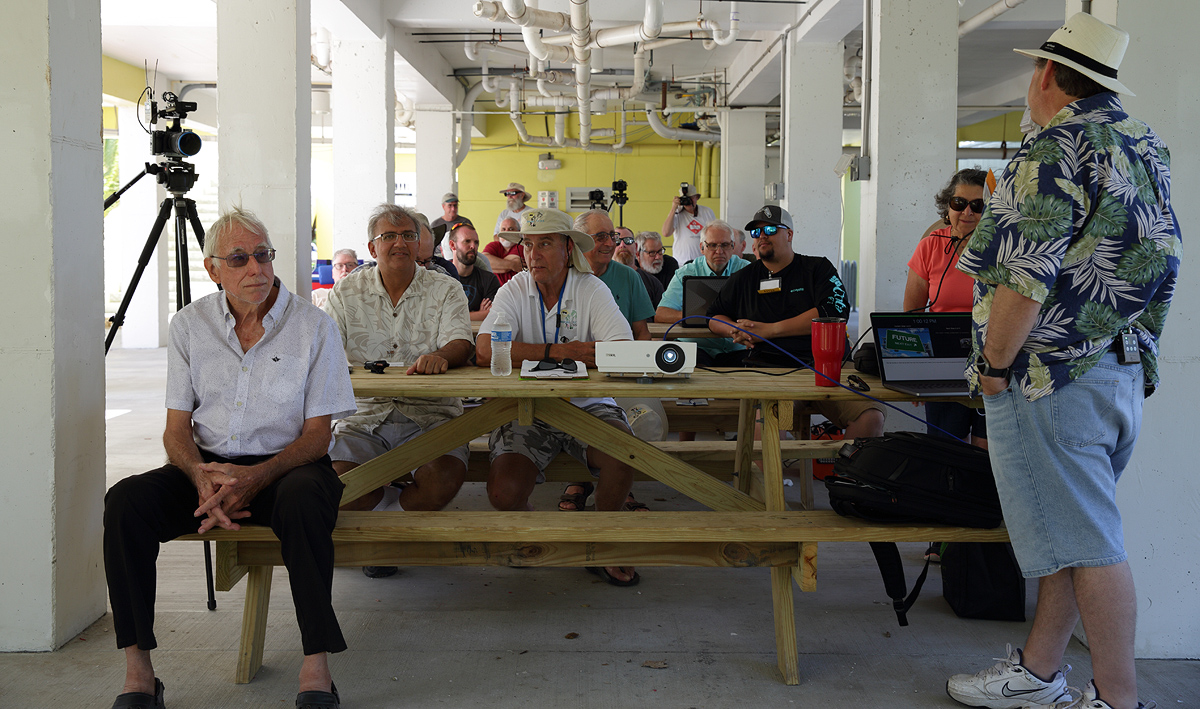 As we were setting up Wednesday night, we heard construction vehicles driving on the road near us, and the brightest fucking set of lights I have ever seen were telescoped upward on posts and then they illuminated our campsite like it was the middle of the afternoon. I just stood there in disbelief. We had heard they could be doing road work, but the unfortunate timing of them deciding to repave US 1 during star party week was a bit hard to believe until we were being assaulted with photons and noise. I measured the sky with my Sky Quality Meter (SQM) at about magnitude 20.0 at our area, about 20.7-20.8 a bit away from it, and 21.0+ in the other camp to the west, where I was sleeping. Luckily, I had a noisemaker and earplugs to deal with most of the construction noise. 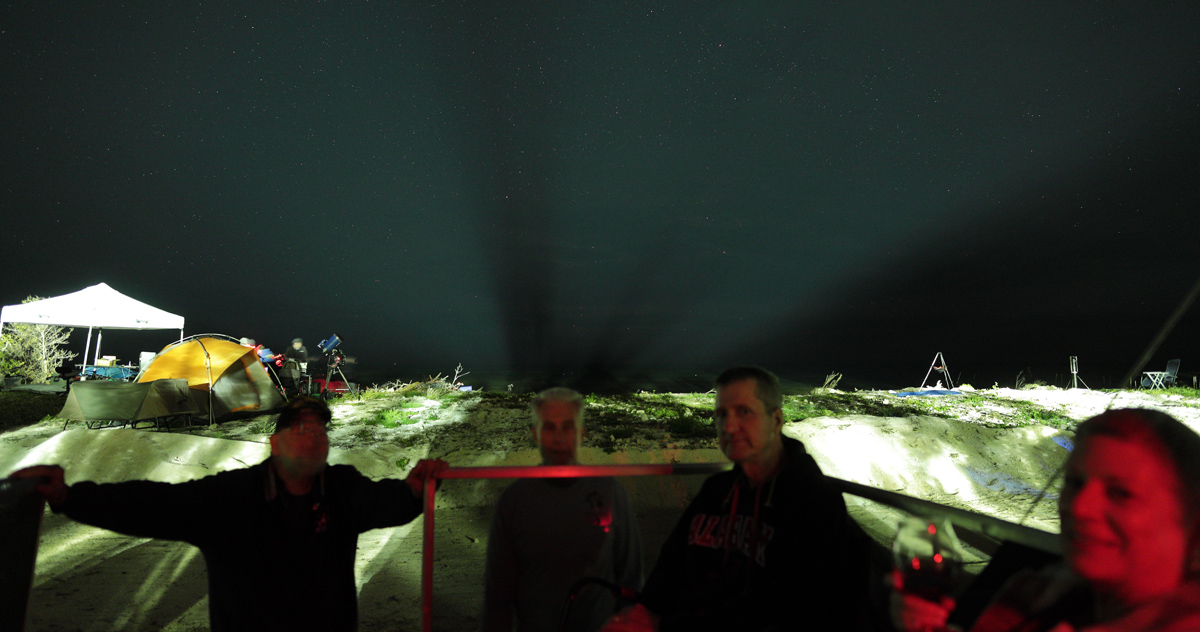 Observing was still possible in other parts of the camp, but on this night we decided on beer tasting instead, sitting on the "porch" on the back of John and Cindy's RV, enjoying (well, sort of) the illuminated view of the ocean (above image). Since we had done a good amount of observing the previous two nights, we were not that angry, we were more annoyed. We rolled with it. I had not done much astrophotography yet, I decided to go down to the water (about 150 feet away) and capture some truly unique images created by the bright lights. This ended up being the image that I entered in the contest, but it did not win any awards. It was definitely unique and very dramatic looking, though, and beautiful in a way. 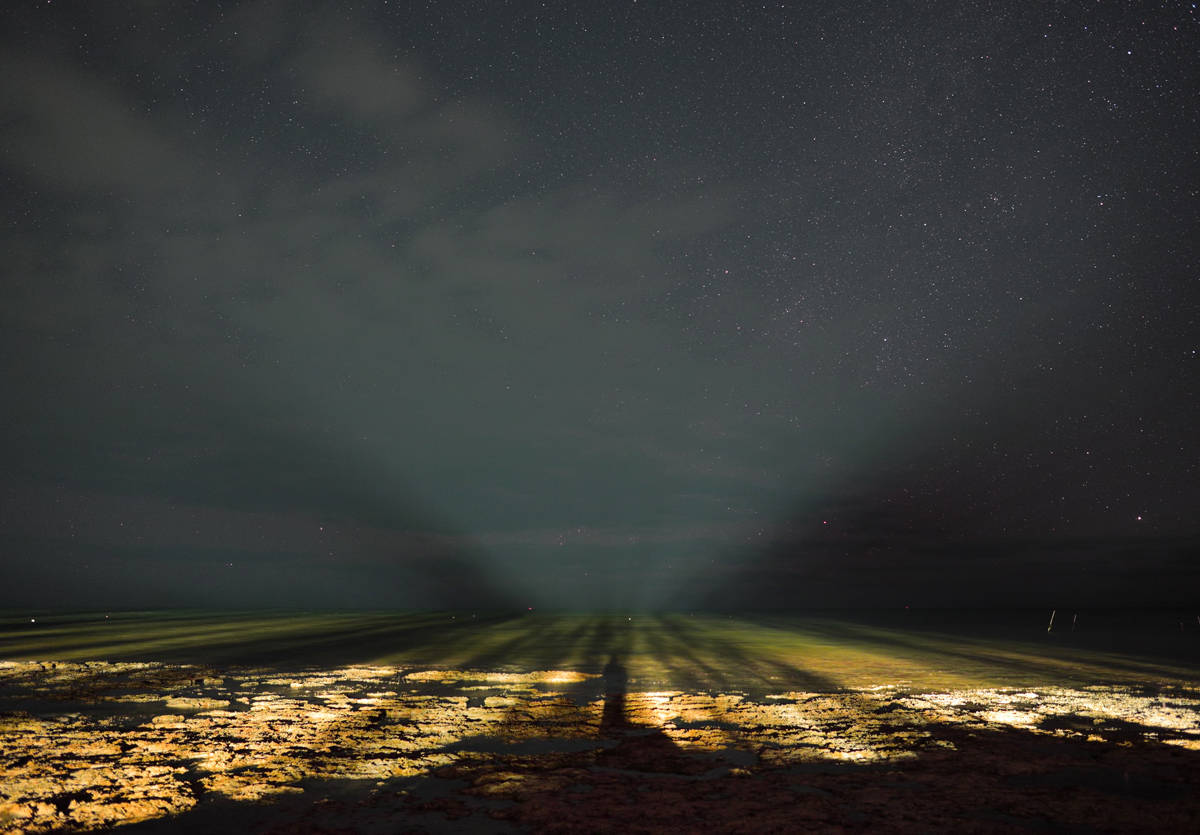 Throughout the night, large machines made unspeakable sounds as they chewed up pavement and put down new asphalt during their overnight work sessions. This was impossible to do during the day because the heavy traffic would paralyze the Keys for tens of miles in either direction, creating a massive traffic jam, a huge inconvenience, and a massive threat to public safety by blocking ambulances and emergency vehicles. Night work was unavoidable, but the timing was fantastically bad. On Thursday night we had dinner at the Steak and Lobster House in Marathon. It's a superb place to eat. After some seafood and key lime pie, we returned, but the lights were still in place. After moving the 22" into the shadow of the RV, it would not align, so we gave up on observing, did another beer tasting, and wandered around a bit to see what others were up to. Losing two nights had started to irritate me, but its hard to get mad on a tropical island with great food, beer, and friends in the middle of winter. We did end up observing a bit with a friend's large binoculars and other equipment set up on the berm, somewhat away from the lights. With Joe's 32" f/3.6, we observed a very pink IC418, NGC 2371 with lobes and star clearly defined, and the Eskimo again, which was showing the inner ring and "chin/mouth". We added a 2x barlow for ridiculously high power, and even more detail was seen. Our previous record, which still stands, is 2600x. It was on this night that Joe decided to move his 32", still assembled, the length of the camp down to the west end of the Girl Scout camp where it was darker and there was some shelter from the wind. He put the wheelbarrow handles on, I grabbed the observing ladder, and others grabbed other items, and we made a very unique group procession down the driveway as others looked on. It's not every day that a 32" telescope passes you by in the middle of the night! This is definitely a unique event in my star party memory. We enjoyed some views through the 32" until it clouded up around 11:30pm. We visited with Harry and friends and then I turned in. There was some light rain overnight. On Friday we attended the giveaway, and I won a battery pack that will be very useful in the future. It was getting very warm, and the humidity was up. We ended up swimming in the afternoon to cool off, and it was great to float in the cool ocean in the swimming hole that had been dug or blasted out of the coral at the end of the dock at the Boy Scout camp. We went to Boondocks for dinner, a great open-air tiki-bar restaurant a few keys to the west. We did a bit of a nightvision session, starting out without a filter, in John's 22" f/3.3 on Friday night, as the lights from hell had finally moved down the road. Going from a friend's notes: NGC 2392 - Chin and teeth clearly visible, the two rings are well separated. Lots of texture in the rings. NGC 40 - very detailed, embedded star in ring a little diffuse. NGC 3132 - Very beautiful, thin crisp ring. Ring is well separated from central star. A relatively bright star is almost touching the ring. Not charted. NGC 3201 - Globular, a foreground of bright stars on a background of innumerable but distinct stars. Very striking. NGC 1851 - Globular, obvious central stars, surrounded by rings of increasingly dimmer stars. Some of the outer stars have a spiral pattern, at least two spiral arms visible. Very interesting. NGC 3242 - 6 Delos - distinct, elongated inner ring superimposed on outer nebulosity. Central star at limit of DV. No color. With 10 Delos NV - Very similar to Eskimo. Bright inner ellipse, bright star. Inner ellipse has brighter fatter lobes at 12-6 Lower and upper part of outer nebulosity is dimmer along the same axis (12-6) (nw-se), very interesting. NGC 4361 - Central star plus some faint nebulosity. 1 star. We started using filters again: Abell 21 Medusa - with 41mm Panoptic, H-alpha filter - wispy Quarter moon aspect, faint, some structure visible. Very faint start embedded in north quadrant. Brighter structure visible to the south. Interesting. NGC 2022 - Not interesting at this mag. Too lazy to change eyepieces! ARO220 - 41 Panoptic - dim, small but interesting cloud of gas to E of central star. With 17mm Delos, no filter, nebula disappeared. Ha shows nebulosity, brighter lobe to E. Overall very dim. Sh2-261 - Lower’s nebula - 17 Delos, Ha - too much magnification but visible. With 41 Panoptic - Fairly loose wisps, approximately U shaped. Dim and diffuse. NGC 2264 - Cone Nebula - Extensive, faint, wispy with a large dark lane in the middle, and an embedded star. Hubble variable nebula - 17 Delos - NF Satanic bird with bright eye, per ML. Very nice. NGC 2282 - Very small. NGC 2452 - 17 Delos - Mini dumbell. Very small at this mag. Central star visible occasionally, though could be artifact. 6 Delos - better view, North lobe has a brighter section. NGC 2440 - 17 Delos - 17D NF two bright close stars, and 2 more dimmer ones in an X pattern. Some highly elongated and textured nebulosity around. Small. 6 Delos - bright stars are actually bright sections of nebulously. Figure 8 shape with additional dim lobe to the west. Interesting. Needs a 50”. NGC 2359 - Duck nebula not good with NV. Forgive the shorthand notes, I just wanted to post them for future reference, and thanks to a friend for taking them. We ended up the night observing again with that friend's equipment on the berm, checking out clusters and southern objects with some very large binoculars. It was a nice way to wrap up what was not a perfect week, but still a very good week. I have to admit that I forgot the battery to my Canon G15 somehow, so I had to get phone photos from friends to show some of the views that we had with the nightvision setup in the 14.5" f/2.5 and 22" f/3.3. Here are the highlights. Most are identifiable, but I'll name them anyway: Centaurus A, Horesehead, Eskimo, Eta Carina (2) and, I believe, the Ghost of Jupiter. 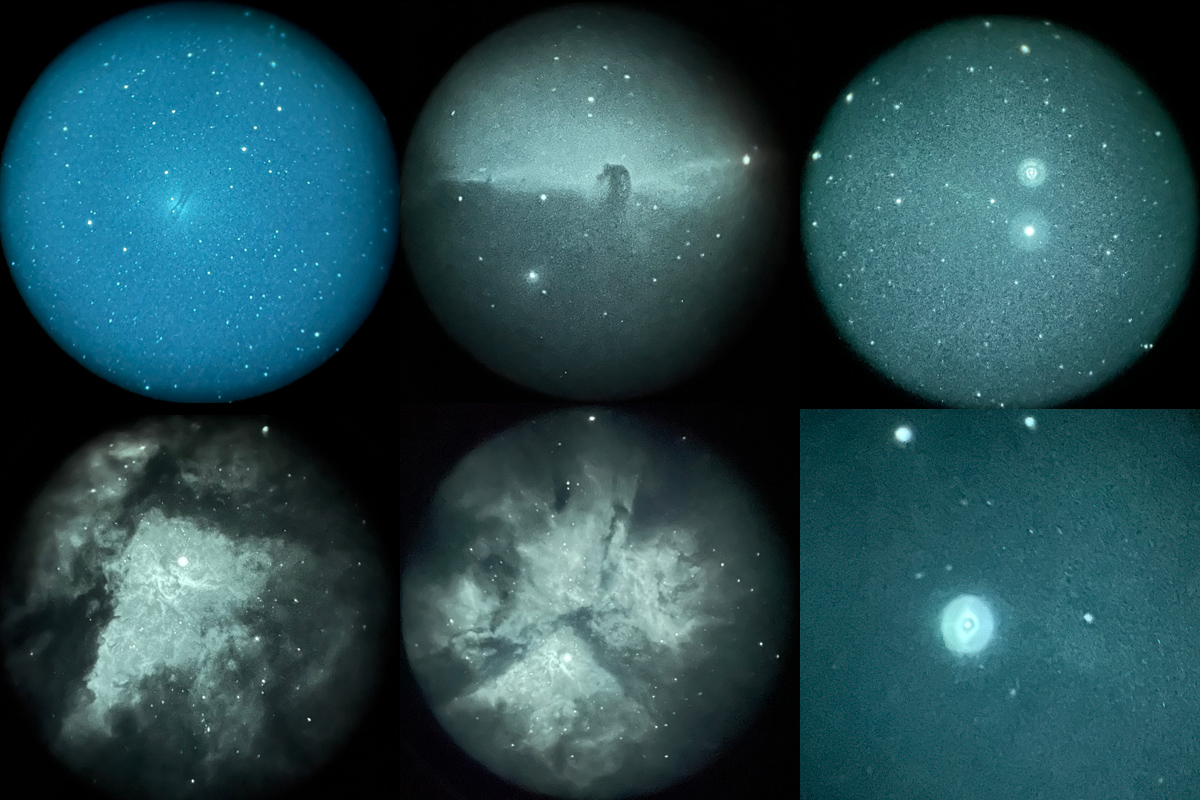 The following morning I got a reasonable start out of the keys, and I didn't hit too much traffic until I was headed north on the turnpike. They call it the "Less Stressway", but not the way Floridians and tourists drive, so I headed to I-95 at the earlier convenience for more lanes and more predictable insanity. I enjoyed the air conditioning in the rental van as I began my journey north, and I hoped for better skies in 2024. It's likely my 12.5" f/2 corrected and dedicated nightvision telescope (NVT?) will make the trip with me, more on that later...... |
Clear, dark, southern skies, no hurricanes, no bioweapons, world peace, good seeing, and cheers. See you at WSP 2024. -Mike Lockwood, Lockwood Custom Optics |